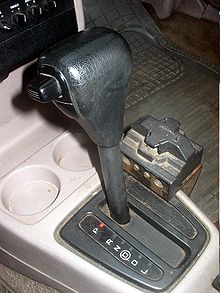
Back Outomatiese ratkas Afrikaans ناقل حركة أوتوماتيكي Arabic Аўтаматычная каробка перадач Byelorussian Transmissió hidràulica automàtica Catalan Automatgear Danish Automatikgetriebe German Transmisión automática Spanish Automaatkäigukast Estonian Transmisio automatiko Basque جعبهدنده خودکار Persian


An automatic transmission (sometimes abbreviated AT) is a multi-speed transmission used in motor vehicles that does not require any input from the driver to change forward gears under normal driving conditions. Vehicles with internal combustion engines, unlike electric vehicles, require the engine to operate in a narrow range of rates of rotation, requiring a gearbox, operated manually or automatically, to drive the wheels over a wide range of speeds.
The most common type of automatic transmission is the hydraulic automatic, which uses a planetary (epicyclic) gearset, hydraulic controls, and a torque converter. Other types of automatic transmissions include continuously variable transmissions (CVT), automated manual transmissions (AMT), and dual-clutch transmissions (DCT).
The 1904 Sturtevant "horseless carriage gearbox" is often considered to be the first true automatic transmission.[1][2][failed verification] The first mass-produced automatic transmission is the General Motors Hydramatic four-speed hydraulic automatic, which was introduced in 1939.
Automatic transmissions are also found in some heavy commercial vehicles, particularly those which are subject to intense stop/start operation such as buses and waste collection vehicles.
- ^ "Automatic Transmissions- A Brief History". AutoServiceExperts. 2003. Archived from the original on 2020-04-18.
- ^ Hearst Autos Research (13 April 2020). "What is an Automatic Car?". Car and Driver. Archived from the original on 2020-04-17.